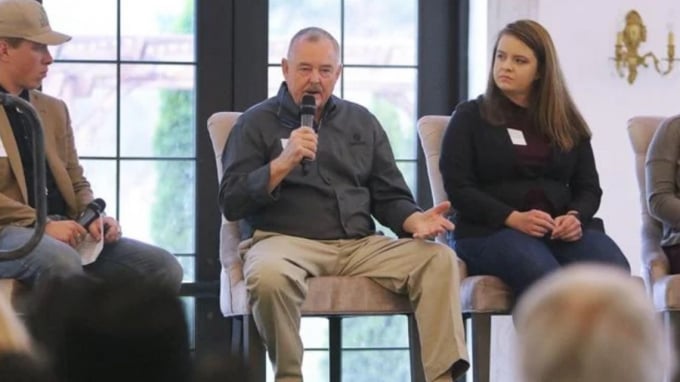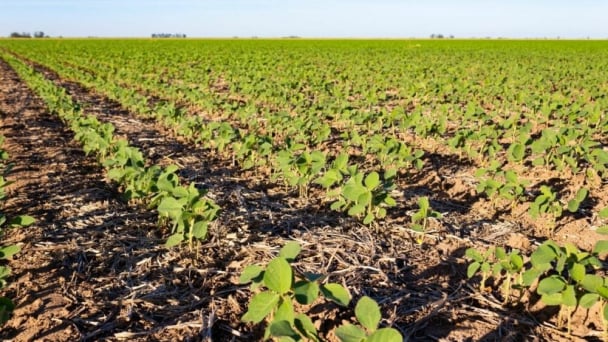May 18, 2025 | 05:56 GMT +7
May 18, 2025 | 05:56 GMT +7
Hotline: 0913.378.918
May 18, 2025 | 05:56 GMT +7
Hotline: 0913.378.918

A panel of experts discuss soil conservation during the "Regenerative Farming Think Tank," at Chateau des Fleurs event center in Eagle, Thursday, April 21, 2022. The event was part of a larger Carbon Summit, organized by Us Energy, on Earth Day. Photo: Brian Myrick/Idaho Press
Rancher and consultant Gabe Brown used to wake up wondering what he should kill that day: weeds, pests, or other organisms that plague agricultural producers. These days, he wakes up asking how he can add more life to his land.
Brown has become a staunch advocate of enhancing soil health to remedy issues facing society — overuse of chemical fertilizers, land degradation, and lack of proper nutrition, to name a few.
“When you realize there are more microorganisms in a teaspoonful of healthy soil than there are people on this planet, that really puts things in perspective,” Brown said. “Let’s work with life.”
Healthy soil, and the microorganisms that live there, play a key role in many natural processes, including water retention, delivering nutrients to plants, and even carbon sequestration. But common farming practices can degrade soil, hampering it from providing such services.
Persuading farmers to adopt practices that promote soil health was the topic of the first annual “Regenerative Farming Think Tank,” held at Chateau des Fleurs in Eagle on Thursday. The event is part of a larger Carbon Summit, organized by Us Energy, that also hosted events at Boise State University on Earth Day, discussing ways to increase sustainability on campus and other topics.
THE DEGRADATION OF SOIL
Humans have only grown food using agriculture for about 12,000 years, according to NPR. But in that time, civilizations have risen and fallen based on how they treated their agricultural soils, David Montgomery, a geomorphology professor at the University of Washington, said at the event.
The plow, a tool used to till soil, is one of the biggest “villains” in this story, Montgomery said. Though plowing land elicits “a little burst of fertility” out of the soil, doing it year after year can degrade organic matter in the soil, he said. The Greeks, Romans, Mesopotamians, and many other civilizations experienced fallout from overworked soils, Montgomery said.
“You can degrade the land enough that it quite literally takes the productivity out of the land that people rely on to feed the population,” Montgomery said.
Soil is naturally good at storing carbon, but tilling disturbs soil, releasing carbon into the atmosphere, which is a driver of climate change, Brown said. About 75% of the carbon that used to be housed in soils is now in the atmosphere, Brown said.
“I’ve been on thousands of farms and ranches all around the world,” Brown said, “and I can honestly say that I haven’t been on a single one, including my own, that isn’t degraded.”
Since World War II, agricultural practices such as the use of chemical fertilizers has further degraded soils, Brown said.
Three years into his career, someone approached Jim Zamzow for advice on why his lawn was not doing well, said Zamzow, who spoke at the event. Zamzow surveyed the lawn and prescribed a product regimen for dealing with crab grass and insects, and recommended feeding the lawn with chemical fertilizers. But the person said they had followed the Zamzow lawn program for three years and it was not working — it was getting worse. The person pointed out that his neighbor, who only applied manure to his lawn once a year, had a much healthier looking lawn than his.
After raising the problem with a local agriculture expert, Zamzow learned that for soil microorganisms to process one unit of nitrogen, they need to consume 12-20 pounds of carbon, he said. Chemical fertilizers applied in excess without taking action to rebuild soil carbon can lead to degraded soils and less optimal growing conditions for plants over time.
Soils stripped of carbon are also inferior at retaining moisture, Brown said.
REGENERATIVE FARMING BENEFITS SOILS
Despite humanity’s track record of degrading soils through agriculture, Montgomery, the geomorphologist, started meeting ranchers and farmers like Brown who are successfully improving soil health, he said. The progress made by farmers like Brown makes Montgomery optimistic.
“It took us centuries to destroy land in different parts of the world,” Montgomery said. “I think we can actually fix a lot of it in the bounds of this century.”
Practices that improve soil health are collectively referred to as regenerative farming, or regenerative agriculture.
Brown says regenerative farming is “to repair, rebuild, revitalize, and restore ecosystem functions, beginning with all life in the soil and moving to all life above the soil.” He says he has yet to meet someone who has a better definition.
What does regenerative agriculture look like in practice? Generally, moving away from tilling, using less chemical fertilizers, and perhaps adding organic matter such as compost to build soils, participants said.
In addition to improving carbon and water storage, healthy soils have the microorganisms that can process and make available key nutrients to plants and crops. For example, most plant roots have relationships with fungi in which the plant provides the fungus with sugars in exchange for nutrients such as phosphorus, Montgomery said. One small study of soil health indicated that healthier soils are better equipped to provide nutrients to plants, and in turn produce food with higher amounts of phytochemicals, or compounds plants make that are beneficial for humans, Montgomery said.
Through his travels, Montgomery has seen regenerative agriculture, and thinks it can work in most environments.
“If we can do that in the next 20 to 30 years, and basically take what is now called regenerative agriculture and make that the new conventional agriculture, in the sense that every (farmer) is doing it, we can solve a problem that has plagued and undermined society, after society, after society around the world,” Montgomery said.
IMPROVED EDUCATION AND KNOWLEDGE COULD SPUR ADOPTION
The panel of experts Thursday discussed a number of barriers to getting farmers and ranchers to adopt regenerative practices.
One barrier is education. Zamzow noted that the main campus of the University of Idaho, the state’s land-grant college where many farmers go for a college education, is located in the Palouse region, which has 30-foot alluvial soils, like in Iowa, he said. The Treasure Valley’s soils “don’t have that luxury,” he said. Tailoring education and regenerative practices toward different crops, as well as local soil and climate could optimize regenerative practices for farmers considering them.
Agricultural classes should include more discussion of life in the soil, not just the chemistry and physics of it, Montgomery said. Brown said his coursework never covered soil life, or the ideal ration of carbon to nitrogen.
Even with good education, it can be difficult for farmers to try new things. For one, they may not be interested in growing crops that could add more biological diversity to their soil and diversify their income, Zamzow said. After Ukraine’s Chernobyl reactor melted down, spewing radiation and rendering the surrounding area largely unsuitable for agriculture, Zamzow tried to approach farmers in northern Idaho about growing some of the herbs that would no longer be grown in that region of Ukraine. But the farmers he talked to preferred to stick with the crops their families had grown for generations, Zamzow said.
Farmers might also face financial barriers to funding new types of inputs, Zamzow said. Financial institutions might be more than willing to finance the use of fertilizers and pesticides but unwilling to finance the purchase of what Zamzow called “foo foo powders” — newer inputs that are not widely considered proven.
Another barrier to education is that farmers historically have had little incentive to talk to and learn from one another about regenerative practices they might be using that could improve soil health, said Jason Marmon, director of development and community relations for Us Energy. It is important to break out of a “trade secrets” mentality and talk to one another to help share best practices, he said.
As inflation and other factors drive up the cost of farming inputs, such as fertilizers, it’s important to help make farmers aware of alternatives, said Katie Baker, executive director for FARE Idaho.
Marmon acknowledged it can be difficult to have candid conversations about regenerative agriculture without bringing politics into it. But it’s important to continue striving for progress, he said.
Brown agreed.
“We have to quit making excuses, and we have to educate ourselves,” he said. “Then, we have to align with the tools that will help us move forward.”
(KTVB)

(VAN) Fourth most important food crop in peril as Latin America and Caribbean suffer from slow-onset climate disaster.

(VAN) Shifting market dynamics and the noise around new legislation has propelled Trouw Nutrition’s research around early life nutrition in poultry. Today, it continues to be a key area of research.

(VAN) India is concerned about its food security and the livelihoods of its farmers if more US food imports are allowed.

(VAN) FAO's Director-General emphasises the need to work together to transform agrifood systems.

(VAN) Europe is facing its worst outbreak of foot-and-mouth since the start of the century.

(VAN) The central authorities, in early April, released a 10-year plan for rural vitalization.

(VAN) Viterra marked a significant milestone in its carbon measurement program in Argentina, called Ígaris, reaching 1 million soybean hectares measured.